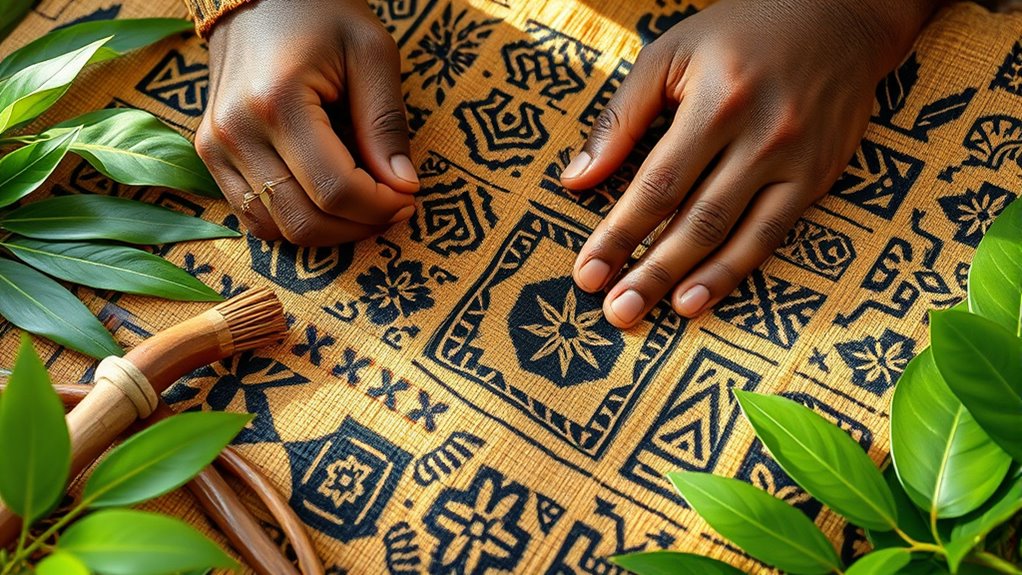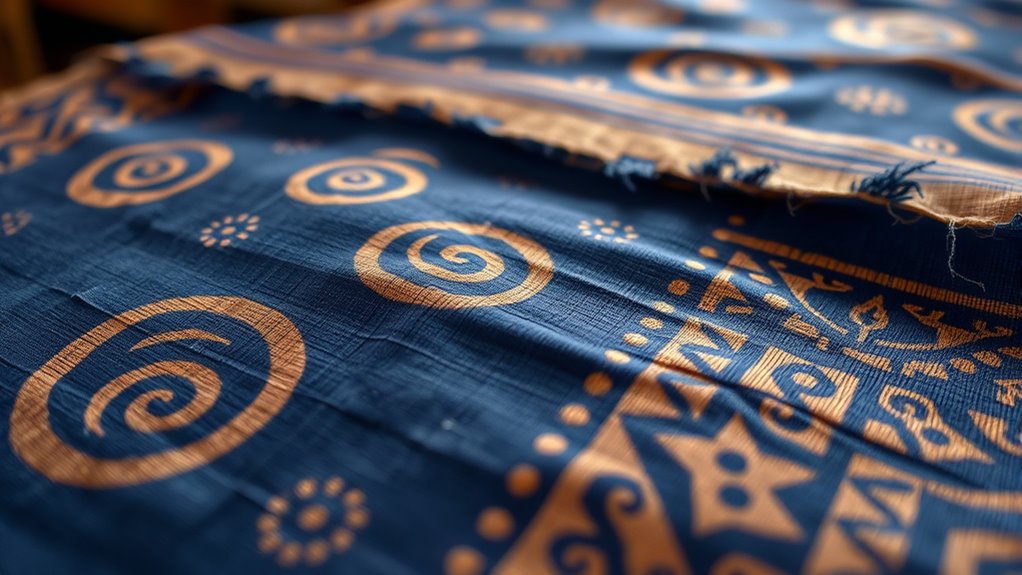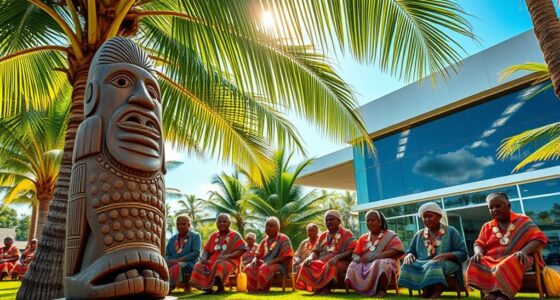The revival of traditional Fijian masi bark cloth art reflects a passionate effort to preserve this ancient craft while adding modern touches. Artisans are blending traditional techniques with new designs, colors, and uses in fashion and décor. Cultural centers and communities actively promote intergenerational knowledge transfer, making masi relevant today. If you keep exploring, you’ll discover how this vibrant tradition continues to evolve and thrive worldwide.
Key Takeaways
- Communities and artisans are actively revitalizing masi through traditional techniques and modern design innovations.
- Cultural institutions and schools promote intergenerational knowledge transfer to preserve masi craftsmanship.
- Modern adaptations include vibrant colors, contemporary patterns, and integration into fashion and décor.
- International interest and exhibitions boost global recognition, encouraging cultural pride and artisan motivation.
- Efforts focus on maintaining authenticity while evolving masi to ensure its relevance for future generations.

Have you ever wondered why the vibrant tradition of Fijian masi bark cloth is making a remarkable comeback? It’s because more people recognize its significance in cultural preservation and are enthusiastic to keep this ancient art form alive. Masi, also known as tapa, is woven from the bark of the paper mulberry tree and has been an essential part of Fijian identity for generations. Historically, it served as clothing, ceremonial fabric, and a symbol of social status. But over time, modernization and changing lifestyles threatened to diminish its relevance. Today, however, artisans and communities are actively reviving masi, blending tradition with modern adaptations to guarantee its survival.
Fijian masi bark cloth is making a vibrant comeback through cultural revival and innovative modern adaptations.
This revival isn’t just about preserving a craft; it’s about safeguarding an indispensable piece of Fijian history. You’ll find that many artists are experimenting with new designs and techniques while respecting traditional motifs. These adaptations make masi more appealing to contemporary audiences, whether through vibrant colors, innovative patterns, or incorporation into fashion and home décor. By doing so, they breathe new life into an age-old tradition, making it relevant in today’s world. Schools and cultural centers also play a role, teaching younger generations about the importance of masi and encouraging them to learn the craft. This intergenerational transfer of knowledge helps maintain authenticity while allowing room for creativity.
Modern adaptations of masi not only attract local interest but also draw global attention. Tourists and collectors seek out these textiles as authentic symbols of Fijian culture, fueling a sense of pride among locals. This renewed appreciation motivates artisans to innovate and promote the craft beyond Fiji’s borders. Social media and international exhibitions showcase stunning examples of masi art, helping to elevate its status and secure its continued relevance. Importantly, this movement highlights that cultural preservation can coexist with innovation. By integrating traditional techniques into contemporary designs, Fijians are affirming that their rich heritage remains dynamic and adaptable.
Furthermore, understanding the traditional techniques involved in masi making is essential for authentic replication and innovation. Ultimately, the revival of Fijian masi bark cloth is a tribute to the power of cultural resilience. You see it in the way artisans are blending old and new, safeguarding their history while embracing modernity. This balance ensures that masi continues to symbolize Fijian identity for generations to come. It’s a compelling reminder that honoring tradition doesn’t mean resisting change; it means evolving in ways that uphold cultural integrity while inspiring new expressions of artistry.
Frequently Asked Questions
How Long Does It Take to Produce Traditional Fijian Masi Bark Cloth?
You’ll find that producing traditional Fijian masi bark cloth can take several days. It begins with harvesting and soaking the bark, then involves traditional dyeing techniques to add vibrant colors. Hand weaving is a meticulous process, shaping the bark into intricate patterns. The entire process, from bark preparation to dyeing and weaving, requires patience and skill, often spanning a week or more, depending on the complexity of the design and size of the cloth.
Are Modern Tools Used in the Creation of Masi Bark Cloth?
Your question about modern tools in masi bark cloth creation is fascinating. You might think traditional methods are untouched by technology, but some artisans now incorporate digital tools and modern techniques to enhance their work. These tools help with design precision, pattern creation, and even scaling artwork. While they don’t replace the traditional process, they definitely give a new edge to this ancient craft, making it more accessible and innovative without losing its cultural essence.
What Are the Main Symbols Depicted in Traditional Masi Designs?
You’ll notice that traditional masi designs feature various symbols with deep significance. These design patterns often include geometric shapes, spirals, and natural motifs like fish, turtles, and plant elements, each symbolizing aspects of Fijian culture such as fertility, prosperity, and spiritual beliefs. The symbol significance in these patterns reflects stories, ancestral connections, and social status, making each piece a meaningful representation of Fijian heritage.
How Is Masi Bark Cloth Preserved for Long-Term Display?
Imagine a delicate tapestry of island history, preserved with gentle care. You use preservation techniques like controlled humidity, temperature stability, and careful handling to safeguard the masi bark cloth. For display methods, you opt for UV-protective glass and strategic lighting that highlight its beauty without damaging it. This careful balance keeps the cloth vibrant and intact, allowing future generations to admire its cultural richness and intricate artistry.
Are There Specific Ceremonies Associated With Masi Creation?
You might wonder if specific ceremonies are tied to masi creation. Yes, these artworks hold deep ceremonial significance and are often created during important cultural rituals. The process usually involves traditional practices passed down through generations, emphasizing respect and spiritual connection. These ceremonies honor ancestors and community values, transforming the act of making masi into a meaningful cultural event that preserves Fiji’s rich heritage.
Conclusion
As you witness the revival of Fijian masi bark cloth, imagine a once-dormant forest coming back to life, vibrant and full of promise. Just like the intricate designs woven into each piece, this movement restores a deep cultural heartbeat. When you see artisans passionately crafting masi, you realize you’re part of a larger story—one where tradition blooms anew, like a seed sprouting after years of silence, ensuring this beautiful art endures for generations to come.










